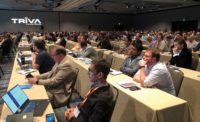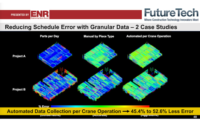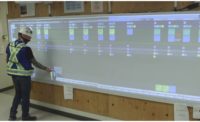A three-day conference providing demonstrations, presentations and networking by firms inventing, piloting and implementing technologies to address construction’s future left attendees bullish on tech prospects for the construction industry and heading home with ideas to deploy.
“I’m taking it all in like a sponge,” said Chris Ovens, executive vice president of strategy and innovation at MEP engineering contractor Modern Niagara Group, Ottawa, Ontario. “It’s good to stop and breathe and connect with other people in the industry and see what kind of work and innovations are going on.”
Mike Loza, regional director for business at BIM consulting firm Sanveo, added, “Ten years ago, they said the industry was five years behind, but now, when looking around at this conference, I think we’re on the cutting edge in some areas.”
ENR FutureTech, held May 31-June 2 in San Francisco, featured 37 speakers in 16 sessions and endless offstage networking. Topics included integrating and implementing tech innovation in project planning and execution, virtual reality, reality capture and drones, among others.
Three of the sessions were streamed live on ENRFutureTech.com and now are archived—with presentations—for viewing.
Keynoters from AECOM and Northrup Grumman set the stage. AECOM reported on how it is leveraging technology to transform and optimize its current and future operations for integrated design-build- finance-operate project delivery.
Jim Dray, AECOM’s CIO for construction services and corporate vice president for business technology solutions, explained the company’s initiatives to apply technology to meet project challenges by using full-text searching of past project documentation to identify and link the expertise held in the 95,000 brains of its workforce and across disciplines to form teams. He spoke of teams using mixed-reality tools, such as the Microsoft HoloLens for virtual collaboration, and of a growing appreciation of data as a project deliverable. “We believe we are pioneering a new way of working,” Dray said.
Dray’s co-presenter, Anthony Sanger, AECOM’s vice president of buildings, showed how the company is using Trimble Connect and iPads to speed RFIs and Trimble’s Vico program management tool to flow project information and “constantly update budgets” while giving real-time project insight through dashboards.
Jerry Buckwalter, director of strategy at aviation giant Northrup Grumman, spoke on keeping an innovation mind-set in mature, stable industries—a descriptive he says fits construction and aviation.
Both construction and aviation, Buckwalter explained, are “mature” industries whose clients drive them to innovate but, for the most part, to push down costs, rather than improve products. Yet, he made the point that companies need product improvement to survive.
“Innovate for the life of your companies,” Buckwalter advised. He said it takes vision, an enabling process, governance and leadership; he also said innovators need to listen to customers, suppliers, researchers and employees across business units to identify opportunities, risks and ideas.
Buckwalter also urged leaders to beware of transformative changes that may abruptly make old solutions obsolete, the way infrastructure plans of London engineers for horse-manure management suddenly were made pointless by the automobile at the start of the 20th century.
Buckwalter warns that additive manufacturing and autonomous vehicles may well make current transportation infrastructure plans obsolete in short order.
“Additive manufacturing [3D printing] means all the goods and components aren’t traveling. The supply chain is no longer necessary and 50% to 70% of the traffic over the roads and seas goes away. That will have implications,” Buckwalter said. He suggests construction experts help their clients to think the future through and not wait for owners to drive innovation. “You’re going to have to help some of your customers create different business models,” he said. “They’re going to have a hard time.”
The metrics for innovation are different from traditional measures of success, Buckwalter added. To innovate well, he said, industry people must be prepared to “fail fast, fail often, then cut the money off and put it on the next idea.”
One session that built on this was a presentation by Rachel Attebery, a business analyst from Black & Veatch who described in detail how the company put together a two-day staff hackathon built around developing new workflows for a document management product already in use: Bluebeam. Employees applied to participate, and engineering students from six schools were recruited to join. Seventeen ideas were generated, five were implemented immediately, and four of the 16 participating students have been hired. It was so successful, the company is planning an expanded repeat on the topic of “Smart Cities, Smart Infrastructure.”
Several attendees said they planned to adopt Black & Veatch’s hackathon model immediately.
Skanska USA Building, Mortenson Construction, HOK and Carrie Dossick, a University of Washington associate professor, shared insights on moving technology to the worksite; the practical and safety implications of deploying sensors, personnel trackers and virtual-reality tools on the jobsites, and capturing field knowledge for next-generation workers. “We stand at the precipice for innovation,” said Walt Terry, vice president for project planning at Skanska. “If we don’t, our competitors will. We have to innovate to survive.”
New product development and research also had a strong presence at the event. Ben Schwegler, chief scientist at Walt Disney Imagineering, with Stanford researcher Forest Flager, gave a presentation about an online structural-steel supply-chain cost-optimizing tool under development by Walt Disney Research China. It lets engineers not only find optimized sizing and cost alternatives while in design but also factor in local workforce economics and cultural constraints at the erection site to ensure the most cost-effective design and delivery.
In another session, “Uncertainty at the Brink of Commitment,” Webcor Builders and its development partner, F3 Associates, debuted an automated point-cloud analysis system they are creating with assistance from Autodesk Forge cloud services. It gives contractors a fast, last-minute comparison between a Navisworks 3D model of a rebar, tendon and blockout layout just before concrete delivery to catch errors before slab casting. “When you pour concrete, that’s pretty much it,” said Peter Sosnowski, preconstruction director at Webcor Builders, adding, “Measurement activities are the lowest cost activities but have the largest impact on construction and project success.”
Away from the main show venue, attendees gathered in corners and adjacent rooms to try out Ekso Bionics’ bionic endurance-enhancing vest, which also was demonstrated on stage, and experiment with Microsoft HoloLens’ augmented-reality headsets brought by CDM Smith, Los Angeles. The engineering consultant gave demonstrations of its beta software for the device and how it can identify clashes in 3D designs.
Using three HoloLens headsets the company received as development kits prior to public release of the system, CDM Smith showed attendees how to view and manipulate holograms of models, find clashes and interact in virtual group meetings with avatars—that is, digital representations of colleagues connecting from other locations.
“We’re already doing what a lot of people are talking about,” says Matthew Harraka, regional VDC manager at CDM Smith, whose avatar wore a clown nose. “We’re testing it on upcoming work.”
Companies presenting technology officers and specialists at FutureTech included AECOM, F3 Associates, Webcor, Walt Disney Research China, Skanska, Mortenson, HOK, JE Dunn Construction Co., Gilbane Building Co., Rizoma, Turner Construction Co., Black & Veatch, McCarthy Building Co., The Weitz Co., Ryan Cos. and Suffolk Construction. Other speakers came from Northrup Grumman, Stanford University’s Center for Integrated Facilities Engineering (CIFE), University of Washington, Ekso Bionics, Aerial Strategies, EarthCam and Dodge Data & Analytics.










Post a comment to this article
Report Abusive Comment